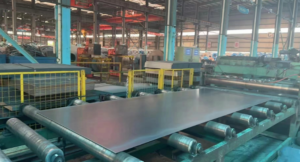In the realm of metallurgy and materials engineering, the terms “بشقاب نورد گرم” and “sheet” are often encountered, yet they are not interchangeable. As a seasoned expert in the field of metal materials from فولاد ضد زنگ سینو, I will delve into the subtle yet significant تفاوت بین صفحه نورد گرم و ورق.

تفاوت بین صفحه نورد گرم و ورق چیست؟
Let’s begin with a fundamental understanding of hot rolled plate. Hot rolling is a manufacturing process where the metal is heated to a temperature above its recrystallization point and then passed through a series of rollers to achieve a desired thickness. This process results in a plate that is thicker and heavier, typically ranging from 4.5mm to several hundred millimeters in thickness. The heating and rolling process enhance the material’s ductility, toughness, and structural integrity, making it suitable for applications that require high strength and durability.
On the other hand, a sheet is a thinner, lighter form of metal product. Sheets are typically produced through cold rolling, a process where the metal is rolled at room temperature, resulting in a smoother surface and closer tolerances. Sheets can vary significantly in thickness, ranging from fractions of a millimeter to several millimeters. Their thinner gauge and lighter weight make them ideal for applications where weight reduction and thinner profiles are crucial.
اولیه تفاوت بین صفحه نورد گرم و ورق lies in their thickness and weight. Hot rolled plates, due to their thicker gauge, are often used in structural applications where high load-bearing capacity is paramount. Bridges, buildings, and heavy machinery are just a few examples where the strength and durability of hot rolled plates are exploited. Sheets, on the other hand, find their use in areas where lighter weight and thinner profiles are desired, such as automotive body panels, roofing materials, and electronic components.
The mechanical properties of hot rolled plates and sheets also differ significantly. Hot rolling improves the toughness and ductility of the metal by refining its grain structure and eliminating internal defects. This results in a material that is not only strong but also resilient, making it suitable for harsh environmental conditions and high-stress applications. Sheets, on the other hand, may exhibit superior surface finish and tighter tolerances due to the cold rolling process. However, their mechanical properties may not match the strength and ductility of hot rolled plates.
In terms of production processes, hot rolling and cold rolling have their own unique requirements and advantages. Hot rolling requires high temperatures and a controlled cooling process to achieve the desired mechanical properties. It is generally more energy-intensive but can produce large quantities of material efficiently. Cold rolling, on the other hand, does not involve heating and is, therefore, more energy-efficient. It also allows for closer tolerances and smoother surfaces, making it suitable for applications where precision is crucial.
The cost of hot rolled plates and sheets can vary depending on several factors, including material type, thickness, production volume, and market demand. Generally speaking, hot rolled plates may command a higher price due to their thicker gauge and the energy-intensive production process involved. Sheets, on the other hand, may be more cost-effective for certain applications due to their lighter weight and efficient production methods. However, the cost-effectiveness of each product ultimately depends on the specific requirements and budget of the project.
It’s also worth noting that both hot rolled plates and sheets can be further processed and customized to meet specific application needs. For instance, they can be cut, punched, welded, or coated with various finishes to enhance their performance or aesthetics. The versatility of these materials adds to their appeal in a wide range of industries.
نتیجه
In conclusion, hot rolled plates and sheets are distinct metal products that differ significantly in thickness, weight, mechanical properties, production processes, and cost.
Thank you for reading our article and we hope it can help you to have a better understanding of the difference between hot rolled plate and sheet. If you are looking for hot rolled plate and sheet online now, we would advise you to visit فولاد ضد زنگ سینو.
به عنوان تامین کننده پیشرو محصولات فولاد ضد زنگ از شانگهای چین، فولاد ضد زنگ سینو کیفیت بالایی را به مشتریان ارائه می دهد. نوارهای فولادی ضد زنگ, ورق های تزئینی فولاد ضد زنگ, لوله های فولادی ضد زنگ, لوله های فولادی ضد زنگ, صفحات فولادی ضد زنگو میله های فولادی ضد زنگ با قیمت بسیار رقابتی
 86 + 18621535697-XNUMX
86 + 18621535697-XNUMX  :export81@huaxia-intl.com
:export81@huaxia-intl.com